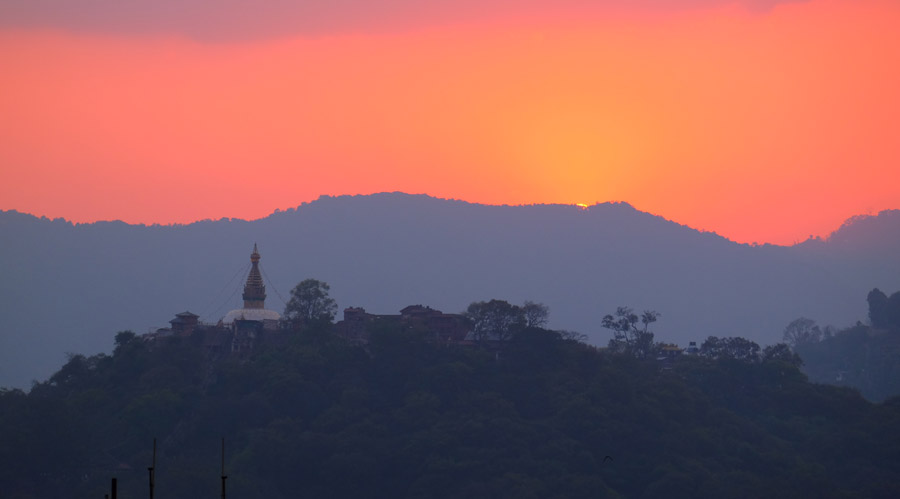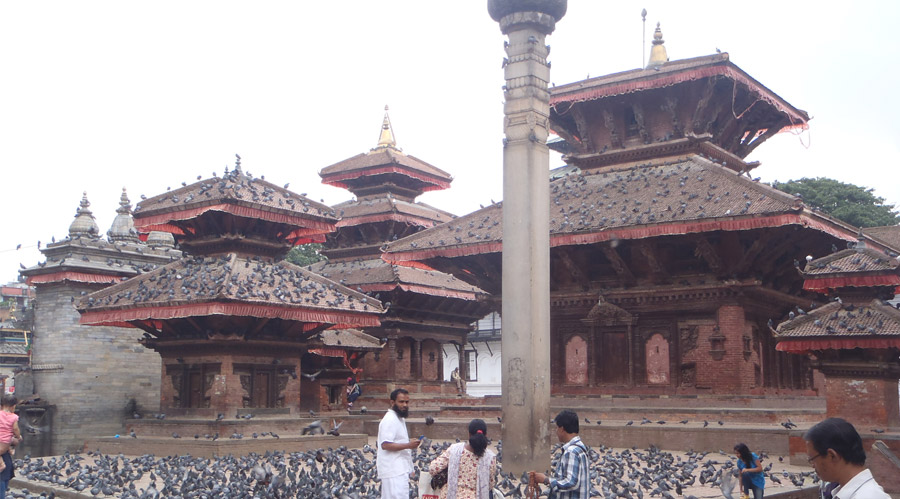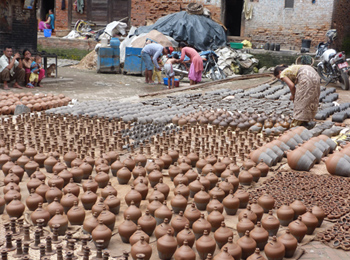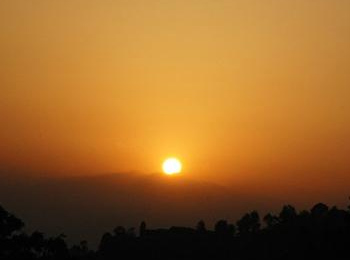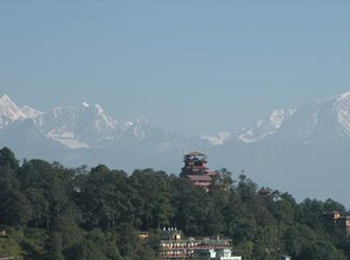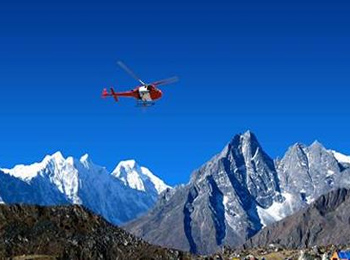- +977 9851074270
- info@mountainramadventures.com
Trip Highlights
- Exploring the UESCO World Heritage Sites within the Kathmandu Valley
- Plenty of time to explore each of the iconic landmarks accompanied by a Cultural Guide.
- Have an inside view of the Nepalese lifestyle.
- Have a better understanding about the landmarks including its history, myths and architectural styles and many more.
- Exquisite view of the Kathmandu Valley from the Swayambhunath Hill
- Opportunity to try cultural meals from the Nepalese Cuisine.
- Purchase local souvenirs from the market vendors.
Detail About Kathmandu Day Tour
Kathmandu Day Tour is a perfect day excursion to enjoy the beauty of Nepal's finest cultural and Historical landmarks reflecting the architectural prowess of the ancient Kingdom of Nepal. The Valley of Kathmandu boasts seven UNESCO Cultural World Heritage Sites in total and on the sightseeing tour organized by the Mountain Ram Adventures the travelers will be visiting five of them. The travelers will be accompanied by an English speaking Cultural Guide for their sightseeing tour who will share the information surrounding the landmarks.
The Kathmandu Day tour begins at around 9 AM as the sightseeing vehicle picks up the travelers from their hotel and transports them to Patan Durbar Square through the traffic heavy roads of Kathmandu. The travelers will be exploring the architectural paradise and visit the nearby landmarks including the Golden Temple and Baglamukhi Temple. The travelers will be traveling to Boudhanath Stupa from Patan and exploring the tranquil Stupa’s vicinity even though located within one of the busiest parts of the Capital. The travelers will be transferred from Boudhanath Stupa to Pashupatinath Temple which is one of the major pilgrimage sites for the followers of Hinduism, dedicated to Lord Shiva. After exploring the beautiful and grand temple complex the travelers will be transferred to Basantapur/ Kathmandu Durbar Square complex which is one of the busiest hubs of the capital as one of the major markets in Kathmandu is situated at the northern part of the Durbar Square. Travelers can purchase souvenirs from the local vendors as there is a wide range to select from at affordable prices. After exploring the beautiful Durbar Square the travelers will be transferred to their final landmark of the tour, Swayambhunath Stupa situated on top of the Gosringa (Semgu) Hill, travelers can witness stellar views of the Kathmandu Valley and if the weather is clear then the views of the Langtang, Rolwaling Himalayan Range can be seen behind the lush green hills on the outskirts of the valley. After the completion of the Kathmandu Day Tour the travelers will be dropped back to their hotel marking an end to the day tour.
Trip Itinerary
Activity 1: Pickup From Hotel and drive to Patan Durbar Square
Activity 2: Explore Patan and transfer to Boudhanath Stupa
Activity 3: Transfer from Boudhanath Stupa to Pashupatinath Temple and explore Temple complex
Activity 4: Pashupatinath Temple to Swayambhunath Temple
Activity 5: Swayambhunath Temple to Basantapur Durbar Square
Activity 6: Drop back to Hotel from Basantapur Durbar Square
Historical Development of the Kathmandu Valley
According to the Swayambhu Purana, the Kathmandu valley used to be a big lake “Nagdaha” translating to “Lake of Snakes”and its water was drained after Bodhisattva Manjushree cut down the hill of Chobar draining the water within the valley using his flame sword Khadga. After most of the water from the Lake drained the lands of the valley began emerging which was fertile and perfect for agriculture resulting in the movement of the Gopals (Cow Herders) who were the first inhabitants of the valley. The Gopal Dynasty came to an end as the Kirat kings came into power marking the beginning of the Kirat Dynasty as early as 3rd century BC. The number of residents of the valley began growing later on during the 6th century under the Kirat rules and their famous Kirat King Yalamber is also mentioned in the epic of Mahabharat. During the rule of the Lichhavis, the first known temple of Kathmandu valley, the Changunarayan Temple was constructed which is listed among the UNESCO World Heritage Sites.
The Kirat dynasty which ruled for around 700 years came to an end by the hands of King Manadeva which marked the beginning of the Licchavi dynasty. During the Licchavi period the valley was introduced to art and religion and the famous Licchivi King, Amshuverma who married his daughter Bhirkuti to the Tibetan king Tsong Tsen Gampo lead to exponential growth of the valleys economy as trade routes with Tibet were established. Later on, the Licchavi dynasty was overthrown by the Malla kings which began the “golden age for art, culture and architecture in Nepal“. During the Malla dynasty there were highly skilled artisans whose contribution led to the creation of magnificent temples, building, courtyards which shaped the history of Nepal during the Malla Period the iconic landmarks including Patan Durbar Square, Bhaktapur Durbar Square and Kathmandu Durbar Square were also constructed during the golden age of Malla Kingdom. Patan Durbar Square used to serve as the royale abode for the Malla kings for centuries. The Kathmandu valley used to be a single kingdom until the death of King Yaksha Malla after which the kingdom was divided into three separate states Kathmandu, Bhaktapur and Lalitpur/Patan. After 550 years of rule, the Malla dynasty was overthrown by King Prithivi Narayan Shah during the unification campaign of Nepal.
Patan Durbar Square
Patan durbar square is an architectural marvel built in the Newari architectural style which served as the Royal residence of the Malla Dynasty from early 14th century to 19th century AD. Patan durbar square portrays the architectural prowess of the ancient Kingdom and is enlisted among the UNESCO Cultural World Heritage Sites. Patan Durbar Square is considered as the oldest durbar square among the three durbar squares: Kathmandu Durbar Square, Bhaktapur durbar square and Patan Durbar square. The ancient city of Patan was previously called “Yala” by its first inhabitants, the Newari. The city later on got the name Lalitpur which translates to “a beautiful place”. The surrounding of the Patan Durbar Square also boasts a number of intricate temple complexes including Golden Temple (oldest temple of Patan believed to be constructed during the 12th century AD), Baglamukhi Temple and many more. The Patan Museum is also located within the vicinity of Patan Durbar Square filled with intricate monuments including wood carvings, bronze idols, stone carvings and many more.
Boudhanath Stupa
Boudhanath Stupa is one of the most revered religious sites for Buddhsim all around the world located at the North-East part of the Kathmandu valley, the Stupa is believed to be constructed during the 5th century AD and brought to its current form/ structure during the 14th century during the Malla Period. The Stupa according to Buddhist folklore is constructed over the remains of a Buddhist Monk which later became a symbol for peace and enlightenment. The Stupa symbolizes the universe through its massive mandala design. The Stupa stands tall at around 36 M in a dome shape surrounded by 108 small stupas and statues making it one of the biggest stupa of Nepal. At top of the dome the all-seeing eyes of Buddha representing wisdom and a third eye representing spiritual insight are painted on the four faces of the Stupa. The pilgrimage visitors are often seen walking around the Stupa in a clockwise direction chatting their mantras/ prayers and spinning the prayer wheels constructed round the dome of the stupa. The Stupa has been a UNESCO World Heritage Sites since 1979 AD.
Pashupatinath Temple
The Pashupatinath Temple constructed on the banks of the holy Bagmati River in Kathmandu is one of the most significant and revered sites for the Hindu community all around the world. The temple is dedicated to the lord of Destruction, Lord Shiva in his Pashupati form meaning the “lord of beasts” and according to the factual data the temple dates back to around 5th century AD but has gone undergone through multiple expansion and renovation processes. The major renovation process took place during the ruling of King Ananta Malla who also added a roof to the temple. The temple attracts devotees all around the world on a daily basis but during the annual festival of Janai Purnima and Maha Shiva Ratri the temple is crowded as thousands of devotees stay in line waiting for their turn from as early as 2 AM. The spawaling temple complex also includes various shrines and statues. The bank of the Bagmati River also serves as one of the biggest cremation sites of the Hindu community in Nepal as according to the faith of believers the devotees who are cremated there find their path to next life easily. The temple was enlisted as a UNESCO World heritage site in 1979 AD. The temple also symbolizes Nepal’s deep rooted connection with Hinduism.
Note: The followers of Hinduism are only permitted to enter the main vicinity of the Pashupatinath Temple and non-hindus are not permitted within the vicinity but can explore other parts of the grand temple complex freely.
Swayambhunath Stupa
Swayambhunath Stupa also called the Monkey Temple is one of the most revered and sacred sites of the country, located on top of the Gosringa Hill. The Swayambhunath Temple origin can be traced as back as 5th century AD, However according to various folklores the origin of the Swayambhunath dates back ever further as it is believed that the Stupa was formed when a lotus flower bloomed in the middle of the Lake which covered the entire valley of Kathmandu. The Bodhisattva Manjuri is said to be responsible for draining the water from the valley which he did by cutting down the Chobar hill using his flame sword, Khadga. The site has been serving as one of the pivotal points for Buddhist pilgrimage for centuries and also for the hindu community similarly. The name Swayambhunath means “self-manifested” or “self-born”. The stupa is constructed on a dome shaped structure abode with a golden spire on top of it. The wisdom eyes of the buddha are facing the four cardinal directions symbolizing his omnipresent awareness. The stupa is surrounded by various shrines, temples and statues which are dedicated to some hindu deities including lord Shiva, the God of destruction. The Swayambhunath Stupa is also one beautiful viewpoint overlooking the Kathmandu Valley and the Himalayas in the back. The iconic landmark has been serving as a center of spiritual practice and Nepalese heritage attracting both pilgrims and tourists. The Stupa has gone through various renovation projects among which mostly took place during “the golden age of art and culture”, the Malla period. The stupa can be accessed by the visitors after climbing a flight of 365 stairs.
Kathmandu Durbar Square
Kathmandu Durbar Square has been the center of the major political events of the county for centuries. The Durbar Square had been serving as the Royal residence till the late 19th century after which the royals shifted to the Narayanhiti Royal Palace. The iconic landmark origin dates back to the Licchavi period who ruled from the 4th century to 9th century AD but was developed massively under the Malla Kings. The site has served for major political events including royal coronation, festivals, celebrations as well as massacres which shifted the nation’s trajectory massively. The complex holds various monuments built during the ruling of different dynasties each showcasing unique architectural characteristics. The iconic temples of the site include Hanuman Dhoka Royal Palace, Kumari Ghar (home of the living Goddess), Taleju Temple and many more. The architectural wonderland was listed as an UNESCO World Heritage Site in 1979 AD and has been one of the must visit places for local and international tourists. The restoration process of the damaged monuments are at its final stages as the landmarks were severely damaged during the earthquake of 2015 AD.
An elevated point of 5416m. You will be mountain climbing in the main on well established trails. Come and join a Great adventure trip.
Cost Includes
- Car or Van
- English speaking tour guide.
Cost Excludes
- Entrance fee for sights.
- Lunch.
- Personal expenses.
- Tipping.
Useful Information
- Essential Required
- The travelers will be required to carry their passport/ ID Card for the journey to obtain the entry pass for the Landmarks.
- As exploring the UNESCO World Heritage site will be on foot the travelers are suggested to wear comfortable footwear and dress modestly as the sightseeing tour includes sacred and religious sites.
- Sun Hat/ Cap and sunscreen is necessary for the Kathmandu Day Tour.
- Entrance Fees for the Kathmandu
The Travelers will need an Entry Pass to explore each of the landmarks which can be obtained easily from the entrance of the Durbar Square. The travelers will be assisted by their Cultural Guide to obtain the Pass. The price of the entry permit is different for foreign citizens and citizens of SAARC countries which will be listed at the Entry Booth of the Sites. - Pickup and Drop Facility
The participants of the trip will be picked up from their Hotel and will be transferred around the landmarks in the vehicle and will be dropped back to their Hotel after the completion of the Kathmandu Day Tour. If the participants of the tour are staying outside the Kathmandu Valley they are requested to arrive at the Head office of the Mountain Ram Adventures at Z-Street, Thamel around 20 minutes before the beginning of the tour and will be dropped back to the Head office after the completion of the tour. - Best Time For Kathmandu Day Tour
Weather Condition: Participating in the Kathmandu Day Tour during the Mid October to Mid Spring season which spans from the months of October to April is the best time to participate as the weather is pleasant with clean blue skies. The travelers can participate in the remaining season however during that time rain can be expected making it difficult to explore the destination and the gloomy clouds covering the skies make the tour less appealing.
During Festival: Traveling during the festival time in Nepal can become the best time as the celebrated festivals in Nepal are vibrant and eventful from the festival of colors (Holi) to various Jatras (Nepalese Carnivals).
Major festivals celebrated in the landmarks
- Basantapur Durbar Square: Holi (March), Indra Jatra (August to September) Gai Jatra (July/ August).
- Patan Durbar Square: Rato Machindranath (Around May lasting around 1 month), Bhoto Jatra (July/August)
- Pashupatinath Temple: Shiva Ratri (February/ March), Janai Purnima (August)
- Boudhanath Stupa: Buddha Jayanti (May)
- Swayambhunath Stupa: Gunla (usually from July to September), Buddha Jayanti (May)
Avoiding Crowd: If the Travelers want to avoid crowds then traveling during the “off season” is better which stretches between December to February and June to August. The cities of Nepal are less crowded with tourists during this time but the travelers can expect anything like unpredictable weather and rainfall. If traveling during the remaining months then the weather condition will be much more favorable but the landmarks will be much crowded.

